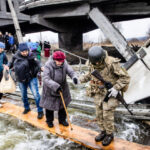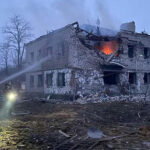By Victoria Friedman
The European Commission unveiled a defense roadmap on Oct. 16 aimed at fortifying the continent against external threats by 2030, and including the creation of a drone wall.
Formally titled the European Drone Defense Initiative, the drone wall project is one of four flagship security schemes—alongside the Eastern Flank Watch, European Air Shield, and European Space Shield—that together outline the European Union’s comprehensive defense effort.
The network is intended to operate in close coordination with NATO.
Some experts say the EU’s rapid move to counter threats could redefine how Europe defends its airspace and strengthen its role within NATO’s framework.
The move follows a series of suspected Russian drone and aircraft incursions into European airspace as the war in Ukraine progresses well into its third year.
Russia has denied NATO’s accusations of repeated violations.
The uptick began on Sept. 9, when Poland said it shot down drones that had breached its airspace—prompting NATO to reinforce its eastern defenses and European Commission President Ursula von der Leyen to call for a “drone wall.”
Similar incidents followed, including Russian aircraft allegedly entering Estonian airspace and drone sightings over Denmark.
In response, the commission has made the European Drone Defense Initiative and Eastern Flank Watch immediate priorities.
What the Drone Wall Could Look Like
The projects are still in the proposal phase, and member states have until the end of this year to decide whether to commit to the strategy.
The European Commission envisages the potential drone defense system as having “flexible, agile, and state-of-the-art” capability to counter unmanned aerial vehicles (UAVs).
It should, the EU’s executive arm says, combine detection, tracking, and neutralization in a multilayered network capable of responding to threats from all directions.
Tomas Nagy, the senior research fellow for nuclear, space, and missile defense at the Globsec think tank, described these three pillars—detection, tracking, and neutralization—as the “classical approach” to air defense.
He agreed with EU Defense Commissioner Andrius Kubilius’s estimate last month that the detection pillar could be operational within a year.
Nagy told The Epoch Times that this was because, “technologically speaking, it’s by far the easiest thing to do.”
“There will need to be decisions made about what kind of technology will be used and how that architecture will be built up, because we can use radars for that or acoustic systems,” he said.
Ukraine’s experience, he noted, has already shown how improvised networks of mobile phones can be used to detect the acoustic patterns of UAVs.
The EU will likely seek more advanced solutions made specifically for military purposes, Nagy said.
The commission has said that the European Drone Defense Initiative should have an initial capacity by the end of 2026, with it being fully functional by the end of 2027.
Neutralizing Threat
Much of how the system will look depends on the individual countries involved.
The commission said that while counter-drone capacity should be “fully interoperable and connected among member states” and able to secure critical infrastructure with NATO, European nations will be responsible for defining their own objectives.
In terms of detection, the Globsec research fellow said: “Each country will need to have its own architecture that will resemble and reflect its geographical and topographical reality, but I’m confident that it can be done pretty quickly, because this is not a new technology.
“This is basically tailoring the existing technology to make sure that it can track targets that are flying at low altitudes.”
Nagy said the final pillar—neutralization—could rely on either kinetic or non-kinetic means.
Kinetic options involve shooting down the target; non-kinetic methods include the use of microwaves, lasers, or jamming electronic systems.
“There’s a number of ways that interception or the final phase of air defense can happen, but there’s no alternative to having a robust infrastructure for sensing, and we need to have what we call ‘Command and Control,’ which connects the first and last phase of air defense, making sure that we see and can engage and that we can follow procedures of how to engage each target,” he said.
NATO Integration
Bartosz Grodecki and Maciej Romanow, experts from the security team at Polish think tank Sobieski Institute, say that a drone wall “is not a physical barrier,” but a coordinated network of sensors, command centers, and technologies designed to “detect, identify, and neutralize hostile drones before they reach critical targets.”
While technically feasible, they warned that threats could evolve faster than the system itself.
“Hostile entities may transition from utilizing low-cost drones to deploying more sophisticated technologies, including swarms of autonomous drones, artificial intelligence-driven weaponry, or integrated cyberattacks targeting defense infrastructure,” they said.
“Concurrently, missile and hybrid threats may escalate, necessitating a more comprehensive air defense strategy than the ‘drone wall’ alone can provide.”
The second priority under the roadmap—the Eastern Flank Watch—will link air, ground, and maritime defense from the Baltic Sea to the Black Sea and integrate fully with NATO’s command structure.
Initial capacity is expected by the end of 2026, with it being functional by the end of 2028.
The EU’s other defense strategies—the European Air Shield and the European Space Shield—will also come into play to ensure broader defense coverage, with all four systems proposed to be able to defend Europe in the next five years.
Building NATO’s European Fortifications
The Sobieski Institute experts argue that initiatives like the drone wall demonstrate Europe’s growing capacity to defend itself—something long-urged by the United States.
They said the EU taking initiative on preparing for new security threats shows “that Europe is not passively relying on the United States, but actively investing in its own defense.”
“This increases Europe’s credibility in Washington and demonstrates a genuine commitment to burden sharing,” they said.
This shift “changes Europe’s position from being a security receiver to becoming a security provider,” they said.
“For the United States, this means a more balanced partnership in which European allies take on part of the financial and technological burden.”
Poland’s central role on NATO’s eastern flank, they added, positions it as the “cornerstone of a new European defense architecture.”
“The concept of a ‘drone wall’ has evolved from a futuristic notion to an immediate strategic necessity,” Grodecki and Romanow said.
“The rapid proliferation of drones and missiles highlights the urgent requirement for resilient, multi-layered air-defense systems.
“The ongoing conflict in Ukraine has clearly illustrated that no nation can consider itself secure without such integrated protection.”





